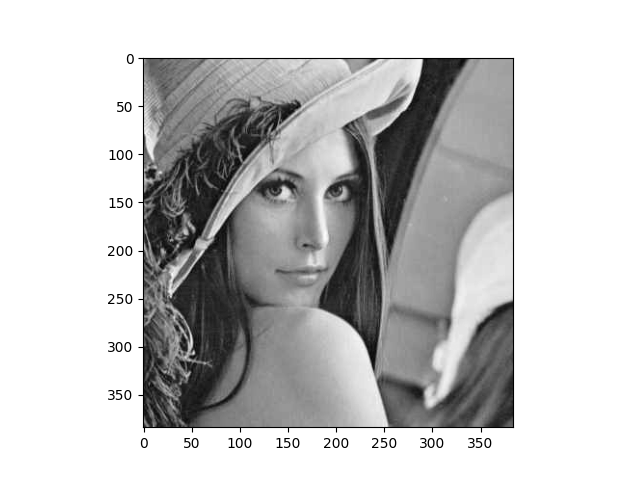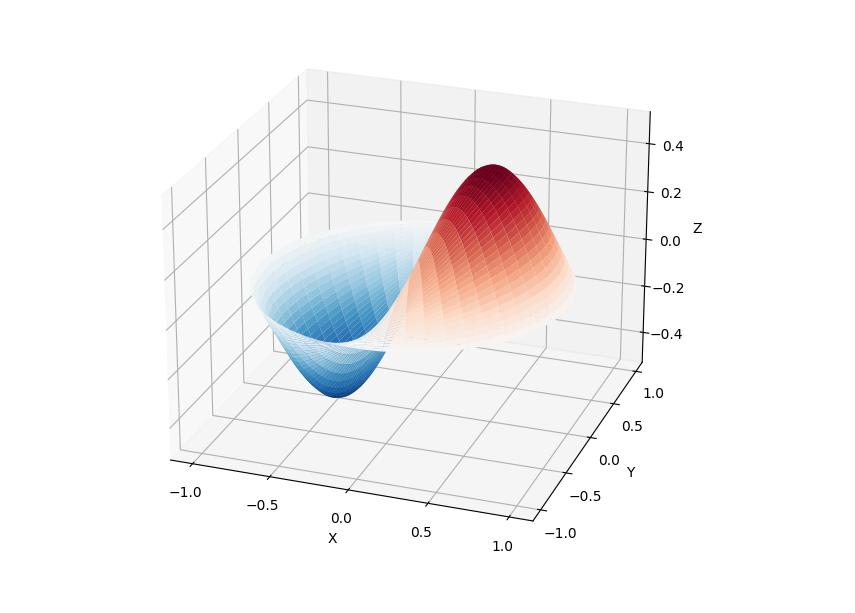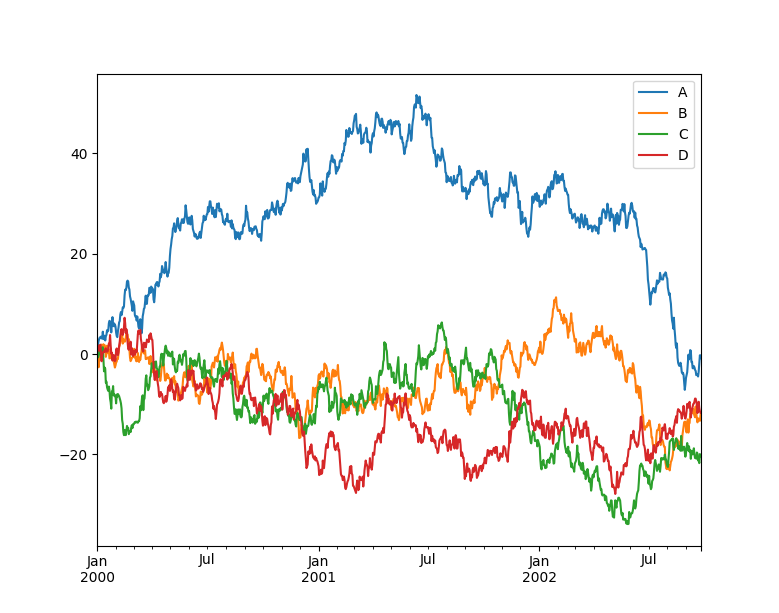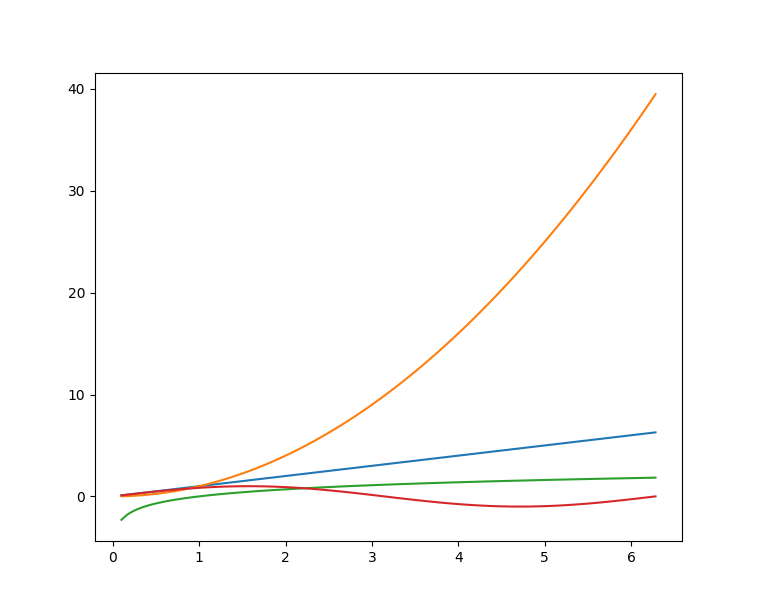?
為了大家能夠?qū)?a target="_blank">人工智能常用的 Python 庫有一個初步的了解,以選擇能夠滿足自己需求的庫進(jìn)行學(xué)習(xí),對目前較為常見的人工智能庫進(jìn)行簡要全面的介紹。
?
??
Numpy
NumPy(Numerical Python)是 Python的一個擴(kuò)展程序庫,支持大量的維度數(shù)組與矩陣運(yùn)算,此外也針對數(shù)組運(yùn)算提供大量的數(shù)學(xué)函數(shù)庫,Numpy底層使用C語言編寫,數(shù)組中直接存儲對象,而不是存儲對象指針,所以其運(yùn)算效率遠(yuǎn)高于純Python代碼。我們可以在示例中對比下純Python與使用Numpy庫在計算列表sin值的速度對比:
import?numpy?as?np import?math import?random import?time start?=?time.time() for?i?in?range(10): ????list_1?=?list(range(1,10000)) ????for?j?in?range(len(list_1)): ????????list_1[j]?=?math.sin(list_1[j]) print("使用純Python用時{}s".format(time.time()-start)) start?=?time.time() for?i?in?range(10): ????list_1?=?np.array(np.arange(1,10000)) ????list_1?=?np.sin(list_1) print("使用Numpy用時{}s".format(time.time()-start))
從如下運(yùn)行結(jié)果,可以看到使用Numpy 庫的速度快于純 Python 編寫的代碼:使用純Python用時0.017444372177124023s 使用Numpy用時0.001619577407836914s
?
? ?OpenCVOpenCV 是一個的跨平臺計算機(jī)視覺庫,可以運(yùn)行在 Linux、Windows 和 Mac OS 操作系統(tǒng)上。它輕量級而且高效——由一系列 C 函數(shù)和少量 C++ 類構(gòu)成,同時也提供了 Python 接口,實(shí)現(xiàn)了圖像處理和計算機(jī)視覺方面的很多通用算法。下面代碼嘗試使用一些簡單的濾鏡,包括圖片的平滑處理、高斯模糊等:import?numpy?as?np import?cv2?as?cv from?matplotlib?import?pyplot?as?plt img?=?cv.imread('h89817032p0.png') kernel?=?np.ones((5,5),np.float32)/25 dst?=?cv.filter2D(img,-1,kernel) blur_1?=?cv.GaussianBlur(img,(5,5),0) blur_2?=?cv.bilateralFilter(img,9,75,75) plt.figure(figsize=(10,10)) plt.subplot(221),plt.imshow(img[:,:,::-1]),plt.title('Original') plt.xticks([]),?plt.yticks([]) plt.subplot(222),plt.imshow(dst[:,:,::-1]),plt.title('Averaging') plt.xticks([]),?plt.yticks([]) plt.subplot(223),plt.imshow(blur_1[:,:,::-1]),plt.title('Gaussian') plt.xticks([]),?plt.yticks([]) plt.subplot(224),plt.imshow(blur_1[:,:,::-1]),plt.title('Bilateral') plt.xticks([]),?plt.yticks([]) plt.show()
 OpenCV
?
OpenCV
?Scikit-image
scikit-image是基于scipy的圖像處理庫,它將圖片作為numpy數(shù)組進(jìn)行處理。例如,可以利用scikit-image改變圖片比例,scikit-image提供了rescale、resize以及downscale_local_mean等函數(shù)。from?skimage?import?data,?color,?io from?skimage.transform?import?rescale,?resize,?downscale_local_mean image?=?color.rgb2gray(io.imread('h89817032p0.png')) image_rescaled?=?rescale(image,?0.25,?anti_aliasing=False) image_resized?=?resize(image,?(image.shape[0]?//?4,?image.shape[1]?//?4), ???????????????????????anti_aliasing=True) image_downscaled?=?downscale_local_mean(image,?(4,?3)) plt.figure(figsize=(20,20)) plt.subplot(221),plt.imshow(image,?cmap='gray'),plt.title('Original') plt.xticks([]),?plt.yticks([]) plt.subplot(222),plt.imshow(image_rescaled,?cmap='gray'),plt.title('Rescaled') plt.xticks([]),?plt.yticks([]) plt.subplot(223),plt.imshow(image_resized,?cmap='gray'),plt.title('Resized') plt.xticks([]),?plt.yticks([]) plt.subplot(224),plt.imshow(image_downscaled,?cmap='gray'),plt.title('Downscaled') plt.xticks([]),?plt.yticks([]) plt.show()
 Scikit-image
?PIL
Scikit-image
?PILPython Imaging Library(PIL) 已經(jīng)成為 Python 事實(shí)上的圖像處理標(biāo)準(zhǔn)庫了,這是由于,PIL 功能非常強(qiáng)大,但API卻非常簡單易用。但是由于PIL僅支持到 Python 2.7,再加上年久失修,于是一群志愿者在 PIL 的基礎(chǔ)上創(chuàng)建了兼容的版本,名字叫 Pillow,支持最新 Python 3.x,又加入了許多新特性,因此,我們可以跳過 PIL,直接安裝使用 Pillow。
?
?Pillow使用 Pillow 生成字母驗(yàn)證碼圖片:from?PIL?import?Image,?ImageDraw,?ImageFont,?ImageFilter import?random #?隨機(jī)字母: def?rndChar(): ????return?chr(random.randint(65,?90)) #?隨機(jī)顏色1: def?rndColor(): ????return?(random.randint(64,?255),?random.randint(64,?255),?random.randint(64,?255)) #?隨機(jī)顏色2: def?rndColor2(): ????return?(random.randint(32,?127),?random.randint(32,?127),?random.randint(32,?127)) #?240?x?60: width?=?60?*?6 height?=?60?*?6 image?=?Image.new('RGB',?(width,?height),?(255,?255,?255)) #?創(chuàng)建Font對象: font?=?ImageFont.truetype('/usr/share/fonts/wps-office/simhei.ttf',?60) #?創(chuàng)建Draw對象: draw?=?ImageDraw.Draw(image) #?填充每個像素: for?x?in?range(width): ????for?y?in?range(height): ????????draw.point((x,?y),?fill=rndColor()) #?輸出文字: for?t?in?range(6): ????draw.text((60?*?t?+?10,?150),?rndChar(),?font=font,?fill=rndColor2()) #?模糊: image?=?image.filter(ImageFilter.BLUR) image.save('code.jpg',?'jpeg')
 驗(yàn)證碼
?SimpleCV
驗(yàn)證碼
?SimpleCVSimpleCV 是一個用于構(gòu)建計算機(jī)視覺應(yīng)用程序的開源框架。使用它,可以訪問高性能的計算機(jī)視覺庫,如 OpenCV,而不必首先了解位深度、文件格式、顏色空間、緩沖區(qū)管理、特征值或矩陣等術(shù)語。但其對于 Python3 的支持很差很差,在 Python3.7 中使用如下代碼:from?SimpleCV?import?Image,?Color,?Display #?load?an?image?from?imgur img?=?Image('http://i.imgur.com/lfAeZ4n.png') #?use?a?keypoint?detector?to?find?areas?of?interest feats?=?img.findKeypoints() #?draw?the?list?of?keypoints feats.draw(color=Color.RED) #?show?the??resulting?image.? img.show() #?apply?the?stuff?we?found?to?the?image. output?=?img.applyLayers() #?save?the?results. output.save('juniperfeats.png') 會報如下錯誤,因此不建議在
Python3 中使用:SyntaxError:?Missing?parentheses?in?call?to?'print'.?Did?you?mean?print('unit?test')?
?
?
?
MahotasMahotas 是一個快速計算機(jī)視覺算法庫,其構(gòu)建在 Numpy 之上,目前擁有超過100種圖像處理和計算機(jī)視覺功能,并在不斷增長。使用 Mahotas 加載圖像,并對像素進(jìn)行操作:import?numpy?as?np import?mahotas import?mahotas.demos from?mahotas.thresholding?import?soft_threshold from?matplotlib?import?pyplot?as?plt from?os?import?path f?=?mahotas.demos.load('lena',?as_grey=True) f?=?f[128:,128:] plt.gray() #?Show?the?data: print("Fraction?of?zeros?in?original?image:?{0}".format(np.mean(f==0))) plt.imshow(f) plt.show()
 Mahotas
Mahotas?
?
IlastikIlastik 能夠給用戶提供良好的基于機(jī)器學(xué)習(xí)的生物信息圖像分析服務(wù),利用機(jī)器學(xué)習(xí)算法,輕松地分割,分類,跟蹤和計數(shù)細(xì)胞或其他實(shí)驗(yàn)數(shù)據(jù)。大多數(shù)操作都是交互式的,并不需要機(jī)器學(xué)習(xí)專業(yè)知識。
??
?
Scikit-learnScikit-learn 是針對 Python 編程語言的免費(fèi)軟件機(jī)器學(xué)習(xí)庫。它具有各種分類,回歸和聚類算法,包括支持向量機(jī),隨機(jī)森林,梯度提升,k均值和 DBSCAN 等多種機(jī)器學(xué)習(xí)算法。使用Scikit-learn實(shí)現(xiàn)KMeans算法:import?time import?numpy?as?np import?matplotlib.pyplot?as?plt from?sklearn.cluster?import?MiniBatchKMeans,?KMeans from?sklearn.metrics.pairwise?import?pairwise_distances_argmin from?sklearn.datasets?import?make_blobs #?Generate?sample?data np.random.seed(0) batch_size?=?45 centers?=?[[1,?1],?[-1,?-1],?[1,?-1]] n_clusters?=?len(centers) X,?labels_true?=?make_blobs(n_samples=3000,?centers=centers,?cluster_std=0.7) #?Compute?clustering?with?Means k_means?=?KMeans(init='k-means++',?n_clusters=3,?n_init=10) t0?=?time.time() k_means.fit(X) t_batch?=?time.time()?-?t0 #?Compute?clustering?with?MiniBatchKMeans mbk?=?MiniBatchKMeans(init='k-means++',?n_clusters=3,?batch_size=batch_size, ??????????????????????n_init=10,?max_no_improvement=10,?verbose=0) t0?=?time.time() mbk.fit(X) t_mini_batch?=?time.time()?-?t0 #?Plot?result fig?=?plt.figure(figsize=(8,?3)) fig.subplots_adjust(left=0.02,?right=0.98,?bottom=0.05,?top=0.9) colors?=?['#4EACC5',?'#FF9C34',?'#4E9A06'] #?We?want?to?have?the?same?colors?for?the?same?cluster?from?the #?MiniBatchKMeans?and?the?KMeans?algorithm.?Let's?pair?the?cluster?centers?per #?closest?one. k_means_cluster_centers?=?k_means.cluster_centers_ order?=?pairwise_distances_argmin(k_means.cluster_centers_, ??????????????????????????????????mbk.cluster_centers_) mbk_means_cluster_centers?=?mbk.cluster_centers_[order] k_means_labels?=?pairwise_distances_argmin(X,?k_means_cluster_centers) mbk_means_labels?=?pairwise_distances_argmin(X,?mbk_means_cluster_centers) #?KMeans for?k,?col?in?zip(range(n_clusters),?colors): ????my_members?=?k_means_labels?==?k ????cluster_center?=?k_means_cluster_centers[k] ????plt.plot(X[my_members,?0],?X[my_members,?1],?'w', ????????????markerfacecolor=col,?marker='.') ????plt.plot(cluster_center[0],?cluster_center[1],?'o',?markerfacecolor=col, ????????????markeredgecolor='k',?markersize=6) plt.title('KMeans') plt.xticks(()) plt.yticks(()) plt.show()
 KMeans
KMeans?
?
SciPySciPy 庫提供了許多用戶友好和高效的數(shù)值計算,如數(shù)值積分、插值、優(yōu)化、線性代數(shù)等。SciPy 庫定義了許多數(shù)學(xué)物理的特殊函數(shù),包括橢圓函數(shù)、貝塞爾函數(shù)、伽馬函數(shù)、貝塔函數(shù)、超幾何函數(shù)、拋物線圓柱函數(shù)等等。from?scipy?import?special import?matplotlib.pyplot?as?plt import?numpy?as?np def?drumhead_height(n,?k,?distance,?angle,?t): ????kth_zero?=?special.jn_zeros(n,?k)[-1] ????return?np.cos(t)?*?np.cos(n*angle)?*?special.jn(n,?distance*kth_zero) theta?=?np.r_[0:2*np.pi:50j] radius?=?np.r_[0:1:50j] x?=?np.array([r?*?np.cos(theta)?for?r?in?radius]) y?=?np.array([r?*?np.sin(theta)?for?r?in?radius]) z?=?np.array([drumhead_height(1,?1,?r,?theta,?0.5)?for?r?in?radius]) fig?=?plt.figure() ax?=?fig.add_axes(rect=(0,?0.05,?0.95,?0.95),?projection='3d') ax.plot_surface(x,?y,?z,?rstride=1,?cstride=1,?cmap='RdBu_r',?vmin=-0.5,?vmax=0.5) ax.set_xlabel('X') ax.set_ylabel('Y') ax.set_xticks(np.arange(-1,?1.1,?0.5)) ax.set_yticks(np.arange(-1,?1.1,?0.5)) ax.set_zlabel('Z') plt.show()
 SciPy
SciPy?
?
NLTKNLTK 是構(gòu)建Python程序以處理自然語言的庫。它為50多個語料庫和詞匯資源(如 WordNet )提供了易于使用的接口,以及一套用于分類、分詞、詞干、標(biāo)記、解析和語義推理的文本處理庫、工業(yè)級自然語言處理 (Natural Language Processing, NLP) 庫的包裝器。NLTK被稱為 “a wonderful tool for teaching, and working in, computational linguistics using Python”。import?nltk from?nltk.corpus?import?treebank #?首次使用需要下載 nltk.download('punkt') nltk.download('averaged_perceptron_tagger') nltk.download('maxent_ne_chunker') nltk.download('words') nltk.download('treebank') sentence?=?"""At?eight?o'clock?on?Thursday?morning?Arthur?didn't?feel?very?good.""" #?Tokenize tokens?=?nltk.word_tokenize(sentence) tagged?=?nltk.pos_tag(tokens) #?Identify?named?entities entities?=?nltk.chunk.ne_chunk(tagged) #?Display?a?parse?tree t?=?treebank.parsed_sents('wsj_0001.mrg')[0] t.draw()
 NLTK
NLTK?
?
spaCyspaCy 是一個免費(fèi)的開源庫,用于 Python 中的高級 NLP。它可以用于構(gòu)建處理大量文本的應(yīng)用程序;也可以用來構(gòu)建信息提取或自然語言理解系統(tǒng),或者對文本進(jìn)行預(yù)處理以進(jìn)行深度學(xué)習(xí)。??import?spacy ??texts?=?[ ??????"Net?income?was?$9.4?million?compared?to?the?prior?year?of?$2.7?million.", ??????"Revenue?exceeded?twelve?billion?dollars,?with?a?loss?of?$1b.", ??] ??nlp?=?spacy.load("en_core_web_sm") ??for?doc?in?nlp.pipe(texts,?disable=["tok2vec",?"tagger",?"parser",?"attribute_ruler",?"lemmatizer"]): ??????#?Do?something?with?the?doc?here ??????print([(ent.text,?ent.label_)?for?ent?in?doc.ents])
nlp.pipe 生成 Doc 對象,因此我們可以對它們進(jìn)行迭代并訪問命名實(shí)體預(yù)測:[('$9.4?million',?'MONEY'),?('the?prior?year',?'DATE'),?('$2.7?million',?'MONEY')] [('twelve?billion?dollars',?'MONEY'),?('1b',?'MONEY')]
?
?
?
LibROSAlibrosa 是一個用于音樂和音頻分析的 Python 庫,它提供了創(chuàng)建音樂信息檢索系統(tǒng)所必需的功能和函數(shù)。#?Beat?tracking?example import?librosa #?1.?Get?the?file?path?to?an?included?audio?example filename?=?librosa.example('nutcracker') #?2.?Load?the?audio?as?a?waveform?`y` #????Store?the?sampling?rate?as?`sr` y,?sr?=?librosa.load(filename) #?3.?Run?the?default?beat?tracker tempo,?beat_frames?=?librosa.beat.beat_track(y=y,?sr=sr) print('Estimated?tempo:?{:.2f}?beats?per?minute'.format(tempo)) #?4.?Convert?the?frame?indices?of?beat?events?into?timestamps beat_times?=?librosa.frames_to_time(beat_frames,?sr=sr)
?
?
?
PandasPandas 是一個快速、強(qiáng)大、靈活且易于使用的開源數(shù)據(jù)分析和操作工具, Pandas 可以從各種文件格式比如 CSV、JSON、SQL、Microsoft Excel 導(dǎo)入數(shù)據(jù),可以對各種數(shù)據(jù)進(jìn)行運(yùn)算操作,比如歸并、再成形、選擇,還有數(shù)據(jù)清洗和數(shù)據(jù)加工特征。Pandas 廣泛應(yīng)用在學(xué)術(shù)、金融、統(tǒng)計學(xué)等各個數(shù)據(jù)分析領(lǐng)域。import?matplotlib.pyplot?as?plt import?pandas?as?pd import?numpy?as?np ts?=?pd.Series(np.random.randn(1000),?index=pd.date_range("1/1/2000",?periods=1000)) ts?=?ts.cumsum() df?=?pd.DataFrame(np.random.randn(1000,?4),?index=ts.index,?columns=list("ABCD")) df?=?df.cumsum() df.plot() plt.show()
 Pandas
Pandas?
?
MatplotlibMatplotlib 是Python的繪圖庫,它提供了一整套和 matlab 相似的命令 API,可以生成出版質(zhì)量級別的精美圖形,Matplotlib 使繪圖變得非常簡單,在易用性和性能間取得了優(yōu)異的平衡。使用 Matplotlib 繪制多曲線圖:#?plot_multi_curve.py import?numpy?as?np import?matplotlib.pyplot?as?plt x?=?np.linspace(0.1,?2?*?np.pi,?100) y_1?=?x y_2?=?np.square(x) y_3?=?np.log(x) y_4?=?np.sin(x) plt.plot(x,y_1) plt.plot(x,y_2) plt.plot(x,y_3) plt.plot(x,y_4) plt.show()
 Matplotlib
Matplotlib?
?
SeabornSeaborn 是在 Matplotlib 的基礎(chǔ)上進(jìn)行了更高級的API封裝的Python數(shù)據(jù)可視化庫,從而使得作圖更加容易,應(yīng)該把 Seaborn 視為 Matplotlib 的補(bǔ)充,而不是替代物。import?seaborn?as?sns import?matplotlib.pyplot?as?plt sns.set_theme(style="ticks") df?=?sns.load_dataset("penguins") sns.pairplot(df,?hue="species") plt.show()
 seaborn
seaborn?
?
OrangeOrange 是一個開源的數(shù)據(jù)挖掘和機(jī)器學(xué)習(xí)軟件,提供了一系列的數(shù)據(jù)探索、可視化、預(yù)處理以及建模組件。Orange 擁有漂亮直觀的交互式用戶界面,非常適合新手進(jìn)行探索性數(shù)據(jù)分析和可視化展示;同時高級用戶也可以將其作為 Python 的一個編程模塊進(jìn)行數(shù)據(jù)操作和組件開發(fā)。使用 pip 即可安裝 Orange,好評~$?pip?install?orange3 安裝完成后,在命令行輸入
orange-canvas 命令即可啟動 Orange 圖形界面:$?orange-canvas 啟動完成后,即可看到
Orange 圖形界面,進(jìn)行各種操作。 Orange
Orange?
?
PyBrainPyBrain 是 Python 的模塊化機(jī)器學(xué)習(xí)庫。它的目標(biāo)是為機(jī)器學(xué)習(xí)任務(wù)和各種預(yù)定義的環(huán)境提供靈活、易于使用且強(qiáng)大的算法來測試和比較算法。PyBrain 是 Python-Based Reinforcement Learning, Artificial Intelligence and Neural Network Library 的縮寫。我們將利用一個簡單的例子來展示 PyBrain 的用法,構(gòu)建一個多層感知器 (Multi Layer Perceptron, MLP)。首先,我們創(chuàng)建一個新的前饋網(wǎng)絡(luò)對象:from?pybrain.structure?import?FeedForwardNetwork n?=?FeedForwardNetwork() 接下來,構(gòu)建輸入、隱藏和輸出層:
from?pybrain.structure?import?LinearLayer,?SigmoidLayer inLayer?=?LinearLayer(2) hiddenLayer?=?SigmoidLayer(3) outLayer?=?LinearLayer(1) 為了使用所構(gòu)建的層,必須將它們添加到網(wǎng)絡(luò)中:
n.addInputModule(inLayer) n.addModule(hiddenLayer) n.addOutputModule(outLayer) 可以添加多個輸入和輸出模塊。為了向前計算和反向誤差傳播,網(wǎng)絡(luò)必須知道哪些層是輸入、哪些層是輸出。這就需要明確確定它們應(yīng)該如何連接。為此,我們使用最常見的連接類型,全連接層,由 FullConnection 類實(shí)現(xiàn):
from?pybrain.structure?import?FullConnection in_to_hidden?=?FullConnection(inLayer,?hiddenLayer) hidden_to_out?=?FullConnection(hiddenLayer,?outLayer) 與層一樣,我們必須明確地將它們添加到網(wǎng)絡(luò)中:
n.addConnection(in_to_hidden) n.addConnection(hidden_to_out) 所有元素現(xiàn)在都已準(zhǔn)備就位,最后,我們需要調(diào)用.sortModules()方法使MLP可用:
n.sortModules() 這個調(diào)用會執(zhí)行一些內(nèi)部初始化,這在使用網(wǎng)絡(luò)之前是必要的。 ?
?
?
MilkMILK(MACHINE LEARNING TOOLKIT) 是 Python 語言的機(jī)器學(xué)習(xí)工具包。它主要是包含許多分類器比如 SVMS、K-NN、隨機(jī)森林以及決策樹中使用監(jiān)督分類法,它還可執(zhí)行特征選擇,可以形成不同的例如無監(jiān)督學(xué)習(xí)、密切關(guān)系傳播和由 MILK 支持的 K-means 聚類等分類系統(tǒng)。使用 MILK 訓(xùn)練一個分類器:import?numpy?as?np import?milk features?=?np.random.rand(100,10) labels?=?np.zeros(100) features[50:]?+=?.5 labels[50:]?=?1 learner?=?milk.defaultclassifier() model?=?learner.train(features,?labels) #?Now?you?can?use?the?model?on?new?examples: example?=?np.random.rand(10) print(model.apply(example)) example2?=?np.random.rand(10) example2?+=?.5 print(model.apply(example2))
?
?
?
TensorFlowTensorFlow 是一個端到端開源機(jī)器學(xué)習(xí)平臺。它擁有一個全面而靈活的生態(tài)系統(tǒng),一般可以將其分為 TensorFlow1.x 和 TensorFlow2.x,TensorFlow1.x 與 TensorFlow2.x 的主要區(qū)別在于 TF1.x 使用靜態(tài)圖而 TF2.x 使用Eager Mode動態(tài)圖。這里主要使用TensorFlow2.x作為示例,展示在 TensorFlow2.x 中構(gòu)建卷積神經(jīng)網(wǎng)絡(luò) (Convolutional Neural Network, CNN)。import?tensorflow?as?tf from?tensorflow.keras?import?datasets,?layers,?models #?數(shù)據(jù)加載 (train_images,?train_labels),?(test_images,?test_labels)?=?datasets.cifar10.load_data() #?數(shù)據(jù)預(yù)處理 train_images,?test_images?=?train_images?/?255.0,?test_images?/?255.0 #?模型構(gòu)建 model?=?models.Sequential() model.add(layers.Conv2D(32,?(3,?3),?activation='relu',?input_shape=(32,?32,?3))) model.add(layers.MaxPooling2D((2,?2))) model.add(layers.Conv2D(64,?(3,?3),?activation='relu')) model.add(layers.MaxPooling2D((2,?2))) model.add(layers.Conv2D(64,?(3,?3),?activation='relu')) model.add(layers.Flatten()) model.add(layers.Dense(64,?activation='relu')) model.add(layers.Dense(10)) #?模型編譯與訓(xùn)練 model.compile(optimizer='adam', ??????????????loss=tf.keras.losses.SparseCategoricalCrossentropy(from_logits=True), ??????????????metrics=['accuracy']) history?=?model.fit(train_images,?train_labels,?epochs=10,? ????????????????????validation_data=(test_images,?test_labels))
?
?
?
PyTorchPyTorch 的前身是 Torch,其底層和 Torch 框架一樣,但是使用 Python 重新寫了很多內(nèi)容,不僅更加靈活,支持動態(tài)圖,而且提供了 Python 接口。#?導(dǎo)入庫 import?torch from?torch?import?nn from?torch.utils.data?import?DataLoader from?torchvision?import?datasets from?torchvision.transforms?import?ToTensor,?Lambda,?Compose import?matplotlib.pyplot?as?plt #?模型構(gòu)建 device?=?"cuda"?if?torch.cuda.is_available()?else?"cpu" print("Using?{}?device".format(device)) #?Define?model class?NeuralNetwork(nn.Module): ????def?__init__(self): ????????super(NeuralNetwork,?self).__init__() ????????self.flatten?=?nn.Flatten() ????????self.linear_relu_stack?=?nn.Sequential( ????????????nn.Linear(28*28,?512), ????????????nn.ReLU(), ????????????nn.Linear(512,?512), ????????????nn.ReLU(), ????????????nn.Linear(512,?10), ????????????nn.ReLU() ????????) ????def?forward(self,?x): ????????x?=?self.flatten(x) ????????logits?=?self.linear_relu_stack(x) ????????return?logits model?=?NeuralNetwork().to(device) #?損失函數(shù)和優(yōu)化器 loss_fn?=?nn.CrossEntropyLoss() optimizer?=?torch.optim.SGD(model.parameters(),?lr=1e-3) #?模型訓(xùn)練 def?train(dataloader,?model,?loss_fn,?optimizer): ????size?=?len(dataloader.dataset) ????for?batch,?(X,?y)?in?enumerate(dataloader): ????????X,?y?=?X.to(device),?y.to(device) ????????#?Compute?prediction?error ????????pred?=?model(X) ????????loss?=?loss_fn(pred,?y) ????????#?Backpropagation ????????optimizer.zero_grad() ????????loss.backward() ????????optimizer.step() ????????if?batch?%?100?==?0: ????????????loss,?current?=?loss.item(),?batch?*?len(X) ????????????print(f"loss:?{loss:>7f}??[{current:>5d}/{size:>5d}]")
?
?
?
TheanoTheano 是一個 Python 庫,它允許定義、優(yōu)化和有效地計算涉及多維數(shù)組的數(shù)學(xué)表達(dá)式,建在 NumPy 之上。在 Theano 中實(shí)現(xiàn)計算雅可比矩陣:import?theano import?theano.tensor?as?T x?=?T.dvector('x') y?=?x?**?2 J,?updates?=?theano.scan(lambda?i,?y,x?:?T.grad(y[i],?x),?sequences=T.arange(y.shape[0]),?non_sequences=[y,x]) f?=?theano.function([x],?J,?updates=updates) f([4,?4])
?
?
?
KerasKeras 是一個用 Python 編寫的高級神經(jīng)網(wǎng)絡(luò) API,它能夠以 TensorFlow, CNTK, 或者 Theano 作為后端運(yùn)行。Keras 的開發(fā)重點(diǎn)是支持快速的實(shí)驗(yàn),能夠以最小的時延把想法轉(zhuǎn)換為實(shí)驗(yàn)結(jié)果。from?keras.models?import?Sequential from?keras.layers?import?Dense #?模型構(gòu)建 model?=?Sequential() model.add(Dense(units=64,?activation='relu',?input_dim=100)) model.add(Dense(units=10,?activation='softmax')) #?模型編譯與訓(xùn)練 model.compile(loss='categorical_crossentropy', ??????????????optimizer='sgd', ??????????????metrics=['accuracy']) model.fit(x_train,?y_train,?epochs=5,?batch_size=32)?????????
?
?
?
Caffe在 Caffe2 官方網(wǎng)站上,這樣說道:Caffe2 現(xiàn)在是 PyTorch 的一部分。雖然這些 api 將繼續(xù)工作,但鼓勵使用 PyTorch api。
??
?
MXNetMXNet 是一款設(shè)計為效率和靈活性的深度學(xué)習(xí)框架。它允許混合符號編程和命令式編程,從而最大限度提高效率和生產(chǎn)力。使用 MXNet 構(gòu)建手寫數(shù)字識別模型:import?mxnet?as?mx from?mxnet?import?gluon from?mxnet.gluon?import?nn from?mxnet?import?autograd?as?ag import?mxnet.ndarray?as?F #?數(shù)據(jù)加載 mnist?=?mx.test_utils.get_mnist() batch_size?=?100 train_data?=?mx.io.NDArrayIter(mnist['train_data'],?mnist['train_label'],?batch_size,?shuffle=True) val_data?=?mx.io.NDArrayIter(mnist['test_data'],?mnist['test_label'],?batch_size) #?CNN模型 class?Net(gluon.Block): ????def?__init__(self,?**kwargs): ????????super(Net,?self).__init__(**kwargs) ????????self.conv1?=?nn.Conv2D(20,?kernel_size=(5,5)) ????????self.pool1?=?nn.MaxPool2D(pool_size=(2,2),?strides?=?(2,2)) ????????self.conv2?=?nn.Conv2D(50,?kernel_size=(5,5)) ????????self.pool2?=?nn.MaxPool2D(pool_size=(2,2),?strides?=?(2,2)) ????????self.fc1?=?nn.Dense(500) ????????self.fc2?=?nn.Dense(10) ????def?forward(self,?x): ????????x?=?self.pool1(F.tanh(self.conv1(x))) ????????x?=?self.pool2(F.tanh(self.conv2(x))) ????????#?0?means?copy?over?size?from?corresponding?dimension. ????????#?-1?means?infer?size?from?the?rest?of?dimensions. ????????x?=?x.reshape((0,?-1)) ????????x?=?F.tanh(self.fc1(x)) ????????x?=?F.tanh(self.fc2(x)) ????????return?x net?=?Net() #?初始化與優(yōu)化器定義 #?set?the?context?on?GPU?is?available?otherwise?CPU ctx?=?[mx.gpu()?if?mx.test_utils.list_gpus()?else?mx.cpu()] net.initialize(mx.init.Xavier(magnitude=2.24),?ctx=ctx) trainer?=?gluon.Trainer(net.collect_params(),?'sgd',?{'learning_rate':?0.03}) #?模型訓(xùn)練 #?Use?Accuracy?as?the?evaluation?metric. metric?=?mx.metric.Accuracy() softmax_cross_entropy_loss?=?gluon.loss.SoftmaxCrossEntropyLoss() for?i?in?range(epoch): ????#?Reset?the?train?data?iterator. ????train_data.reset() ????for?batch?in?train_data: ????????data?=?gluon.utils.split_and_load(batch.data[0],?ctx_list=ctx,?batch_axis=0) ????????label?=?gluon.utils.split_and_load(batch.label[0],?ctx_list=ctx,?batch_axis=0) ????????outputs?=?[] ????????#?Inside?training?scope ????????with?ag.record(): ????????????for?x,?y?in?zip(data,?label): ????????????????z?=?net(x) ????????????????#?Computes?softmax?cross?entropy?loss. ????????????????loss?=?softmax_cross_entropy_loss(z,?y) ????????????????#?Backpropogate?the?error?for?one?iteration. ????????????????loss.backward() ????????????????outputs.append(z) ????????metric.update(label,?outputs) ????????trainer.step(batch.data[0].shape[0]) ????#?Gets?the?evaluation?result. ????name,?acc?=?metric.get() ????#?Reset?evaluation?result?to?initial?state. ????metric.reset() ????print('training?acc?at?epoch?%d:?%s=%f'%(i,?name,?acc))
?
?
?
PaddlePaddle飛槳(PaddlePaddle) 以百度多年的深度學(xué)習(xí)技術(shù)研究和業(yè)務(wù)應(yīng)用為基礎(chǔ),集深度學(xué)習(xí)核心訓(xùn)練和推理框架、基礎(chǔ)模型庫、端到端開發(fā)套件、豐富的工具組件于一體。是中國首個自主研發(fā)、功能完備、開源開放的產(chǎn)業(yè)級深度學(xué)習(xí)平臺。使用 PaddlePaddle 實(shí)現(xiàn) LeNtet5:#?導(dǎo)入需要的包 import?paddle import?numpy?as?np from?paddle.nn?import?Conv2D,?MaxPool2D,?Linear ##?組網(wǎng) import?paddle.nn.functional?as?F #?定義?LeNet?網(wǎng)絡(luò)結(jié)構(gòu) class?LeNet(paddle.nn.Layer): ????def?__init__(self,?num_classes=1): ????????super(LeNet,?self).__init__() ????????#?創(chuàng)建卷積和池化層 ????????#?創(chuàng)建第1個卷積層 ????????self.conv1?=?Conv2D(in_channels=1,?out_channels=6,?kernel_size=5) ????????self.max_pool1?=?MaxPool2D(kernel_size=2,?stride=2) ????????#?尺寸的邏輯:池化層未改變通道數(shù);當(dāng)前通道數(shù)為6 ????????#?創(chuàng)建第2個卷積層 ????????self.conv2?=?Conv2D(in_channels=6,?out_channels=16,?kernel_size=5) ????????self.max_pool2?=?MaxPool2D(kernel_size=2,?stride=2) ????????#?創(chuàng)建第3個卷積層 ????????self.conv3?=?Conv2D(in_channels=16,?out_channels=120,?kernel_size=4) ????????#?尺寸的邏輯:輸入層將數(shù)據(jù)拉平[B,C,H,W]?->?[B,C*H*W] ????????#?輸入size是[28,28],經(jīng)過三次卷積和兩次池化之后,C*H*W等于120 ????????self.fc1?=?Linear(in_features=120,?out_features=64) ????????#?創(chuàng)建全連接層,第一個全連接層的輸出神經(jīng)元個數(shù)為64,?第二個全連接層輸出神經(jīng)元個數(shù)為分類標(biāo)簽的類別數(shù) ????????self.fc2?=?Linear(in_features=64,?out_features=num_classes) ????#?網(wǎng)絡(luò)的前向計算過程 ????def?forward(self,?x): ????????x?=?self.conv1(x) ????????#?每個卷積層使用Sigmoid激活函數(shù),后面跟著一個2x2的池化 ????????x?=?F.sigmoid(x) ????????x?=?self.max_pool1(x) ????????x?=?F.sigmoid(x) ????????x?=?self.conv2(x) ????????x?=?self.max_pool2(x) ????????x?=?self.conv3(x) ????????#?尺寸的邏輯:輸入層將數(shù)據(jù)拉平[B,C,H,W]?->?[B,C*H*W] ????????x?=?paddle.reshape(x,?[x.shape[0],?-1]) ????????x?=?self.fc1(x) ????????x?=?F.sigmoid(x) ????????x?=?self.fc2(x) ????????return?x
?
?
?
CNTKCNTK(Cognitive Toolkit) 是一個深度學(xué)習(xí)工具包,通過有向圖將神經(jīng)網(wǎng)絡(luò)描述為一系列計算步驟。在這個有向圖中,葉節(jié)點(diǎn)表示輸入值或網(wǎng)絡(luò)參數(shù),而其他節(jié)點(diǎn)表示對其輸入的矩陣運(yùn)算。CNTK 可以輕松地實(shí)現(xiàn)和組合流行的模型類型,如 CNN 等。CNTK 用網(wǎng)絡(luò)描述語言 (network description language, NDL) 描述一個神經(jīng)網(wǎng)絡(luò)。簡單的說,要描述輸入的 feature,輸入的 label,一些參數(shù),參數(shù)和輸入之間的計算關(guān)系,以及目標(biāo)節(jié)點(diǎn)是什么。NDLNetworkBuilder=[ ???? ????run=ndlLR ???? ????ndlLR=[ ??????#?sample?and?label?dimensions ??????SDim=$dimension$ ??????LDim=1 ???? ??????features=Input(SDim,?1) ??????labels=Input(LDim,?1) ???? ??????#?parameters?to?learn ??????B0?=?Parameter(4)? ??????W0?=?Parameter(4,?SDim) ?????? ?????? ??????B?=?Parameter(LDim) ??????W?=?Parameter(LDim,?4) ???? ??????#?operations ??????t0?=?Times(W0,?features) ??????z0?=?Plus(t0,?B0) ??????s0?=?Sigmoid(z0)??? ?????? ??????t?=?Times(W,?s0) ??????z?=?Plus(t,?B) ??????s?=?Sigmoid(z)???? ???? ??????LR?=?Logistic(labels,?s) ??????EP?=?SquareError(labels,?s) ???? ??????#?root?nodes ??????FeatureNodes=(features) ??????LabelNodes=(labels) ??????CriteriaNodes=(LR) ??????EvalNodes=(EP) ??????OutputNodes=(s,t,z,s0,W0) ????]? ?
審核編輯 :李倩
?
 電子發(fā)燒友App
電子發(fā)燒友App



















評論